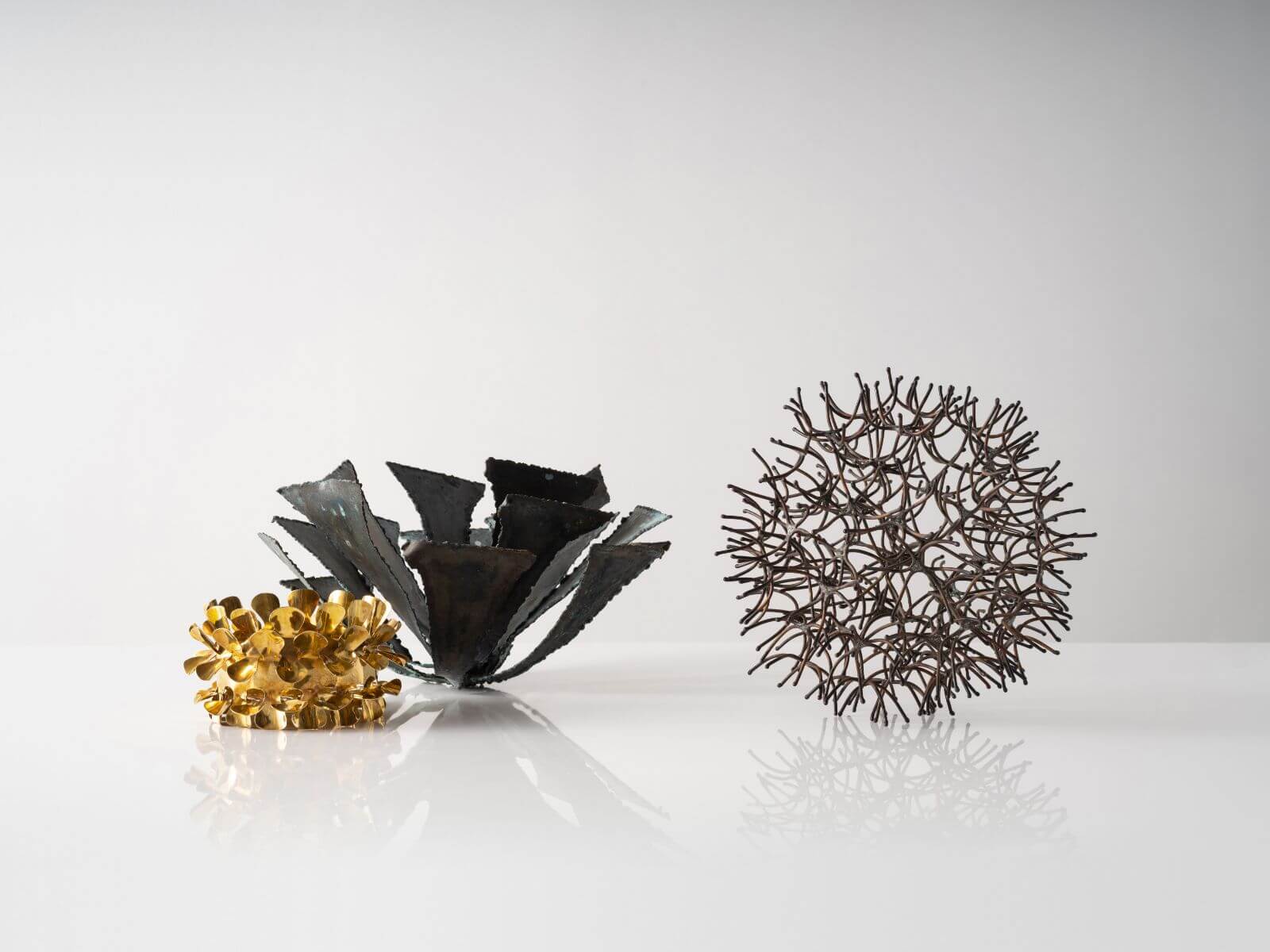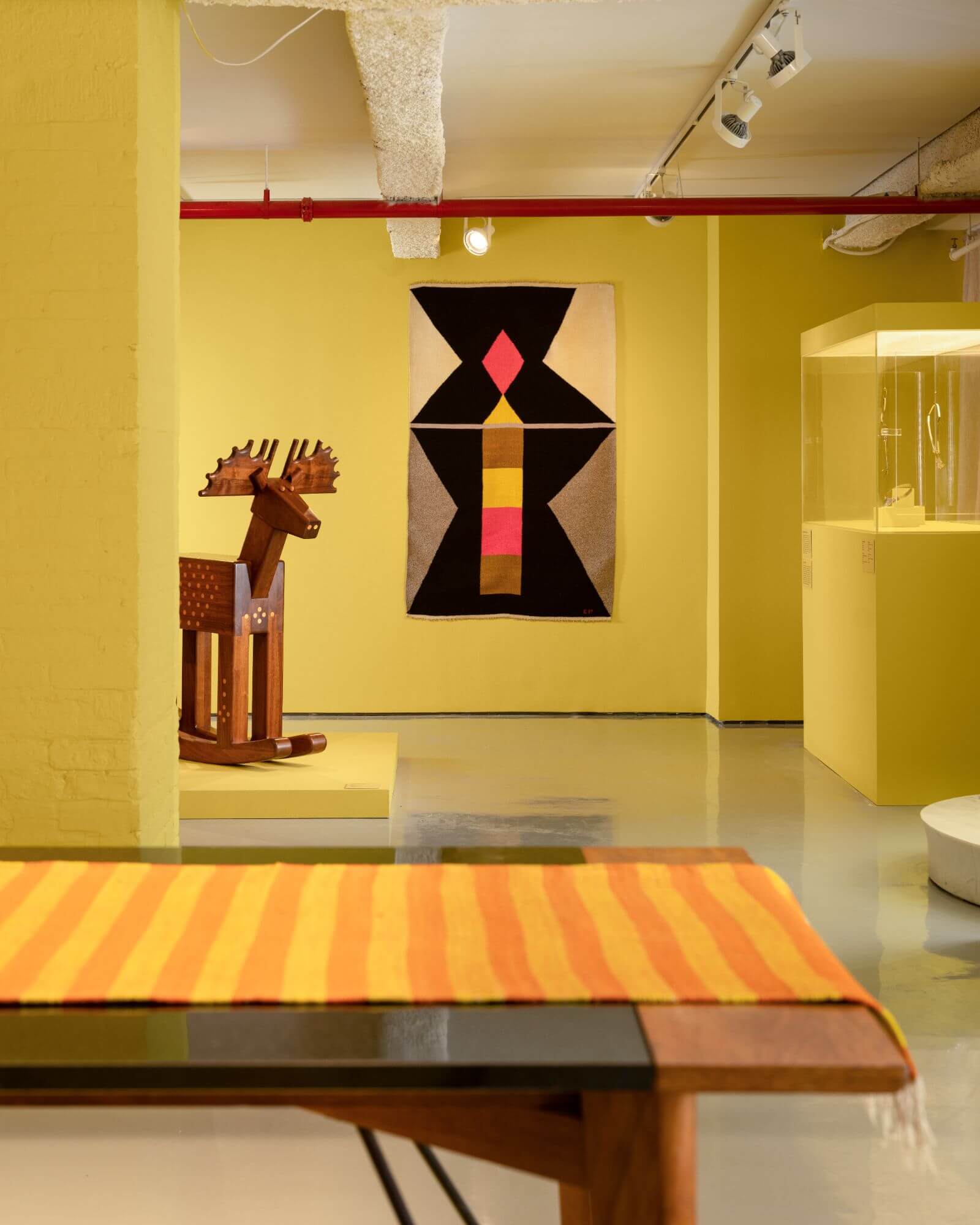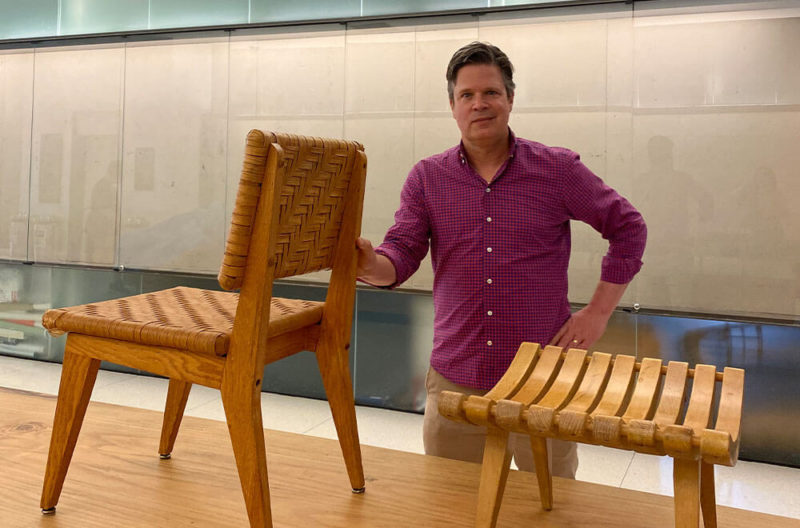Born Too Tall
A historical survey of noted, yet overlooked, women designers from California uncovers their lasting impact.
R & Company, 64 White St, NY
Until 27 January 2023

Evelyn Ackerman, ‘Flower Garden’, 1968. Merry Renk, ‘Model for Crown’, 1960s. Jade Snow Wong, ‘Unique vessel’. Evelyn Ackerman, ‘Lineal’, 1966
COURTESY: R & Company / PHOTOGRAPH: Joe Kramm
SET OFF BY YELLOW backdrops and plinths, a careful selection of furnishings, fabrics and flourishes have taken over R & Company’s sprawling basement level at White Street. Anthropomorphic chairs such as Pamela Weir-Quiton’s iconic ‘Georgie girl’ (1968) sit alongside striking colour-block tapestries like Evelyn Ackerman’s ‘Launch Pad’ (1970). ‘Born Too Tall: California Women Designers, Postwar to Postmodern’ brings together 14 previously forgotten talents that helped define California’s creative scene over the past century.

Exhibition view, ‘Born Too Tall’, R & Company, New York
COURTESY: R & Company / PHOTOGRAPH: Joe Kramm
With the ambitious ‘Objects: USA 2020’ encyclopaedic exhibition mounted last year, R & Company is continuing to shed light on the comprehensive, yet often discounted canon of American design and decorative arts. “Since 2000, [the gallery] has committed significant resources to organise exhibitions that support the rediscovery of ground-breaking objects and the pioneering but sometimes unsung talents that made them,” emphasises co-founder and principal Evan Snyderman.
This latest exhibition, ‘Born Too Tall’, is curated by Snyderman, together with the gallery’s Director of Museum Relations, James Zemaitis. “[This exhibition] provides another opportunity to highlight a group of visionary women designers,” says Snyderman, “many of whom were included in the original ‘Objects: USA’ exhibition in 1969 and who are responsible for many breakthrough moments – making the field more vital, dynamic and complex.”

Trude Guermonprez, ‘Tapestry’, 1973
COURTESY: R & Company / PHOTOGRAPH: Joe Kramm
‘Born Too Tall’ places particular emphasis on women creatives who, until recently, were marginalised by both academia and the collectible market. The show’s title comes from a chapter in exhibitor Jade Snow Wong’s bestselling memoir ‘Fifth Chinese Daughter’ in which she thwarts the efforts of her parents to marry her off, and refers to the struggle that these makers (many of whom are now in their 60s, 70s and 80s) faced in being taken seriously and gaining economic independence.

Merry Renk (left to right), ‘Model for Crown’, ‘Unique object’, ‘Unique hanging sculpture’, 1960s-70s
COURTESY: R & Company / PHOTOGRAPH: Joe Kramm
Featuring 25 works, the show incorporates pieces from well-known designers like Ray Eames and Arline Fisch, as well as pieces by lesser-known names such as Merry Renk and Marguerite Wildenhain. Snyderman and Zemaitis’s goal is to re-examine how these figures pushed the possibilities of ceramics, glass, wood, fibre and metal in their practices. In doing so, they hope to prove their relevance within the field of design history.

Marguerite Wildenhain, Unique vessels in glazed ceramic, 1940-2
COURTESY: R & Company / PHOTOGRAPH: Joe Kramm
Among the key works on display is Wendy Maruyama’s 1981 ‘Mickey Mackintosh’ chair, an unmistakable emblem of Postmodernism and one of the strongest examples of the American Studio Furniture movement.

Wendy Maruyama, ‘Mickey Mackintosh Chairs’, 1981
COURTESY: R & Company / PHOTOGRAPH: Joe Kramm
While the jewellery of Claire Falkenstein reveals the enduring importance of craft, Greta Magnusson Grossman’s pared-back furnishings suggest a much earlier Modernist preoccupation with machine aesthetics and efficiency.

Exhibition view, ‘Born Too Tall’ with table by Greta Magnusson Grossman, R & Company, New York
COURTESY: R & Company / PHOTOGRAPH: Joe Kramm
The exhibition seeks to contextualise these significant makers within their native or adoptive California. Talents like Trude Guermonprez, June Schwarcz and Kay Sekimachi crafted oeuvres that embody the state’s natural beauty, progressive attitude and position within technological advancement. While most of the pieces on view come from R & Company’s own extensive store, a number were procured by the renowned Forrest L. Merrill Collection, regarded as one of the largest and most important private collections of craft and design internationally.

Kay Sekimachi, ‘Basket’, 1977
COURTESY: R & Company / PHOTOGRAPH: Joe Kramm
‘Born Too Tall’ not only surveys the contribution of women designers to the state of California, but also leaves a few open-ended questions – such as what defined and continues to define the state’s creative output?

Pamela Weir-Quiton, ‘Georgie girl’, 1968
COURTESY: R & Company / PHOTOGRAPH: Joe Kramm
Also showing at R & Company is Job Smeets’s new show ‘The American Job’, a collection of drawings and cast bronze sculptures. Both exhibitions try to capture the essence of the vast and socially convoluted geography of the United States. Smeets’s show explores perceived iconographies stemming from observations made during a cross-country road trip back in 2019. ‘Born Too Tall’ on the other hand demonstrates the complexity of deep-seated gender politics, vernacular craft traditions, material innovations, regional variations and the integral role they played in shaping historical design.

Merry Renk, ‘Model for Crown’, 1960s
COURTESY: R & Company / PHOTOGRAPH: Joe Kramm







